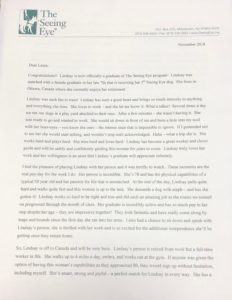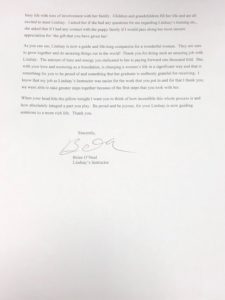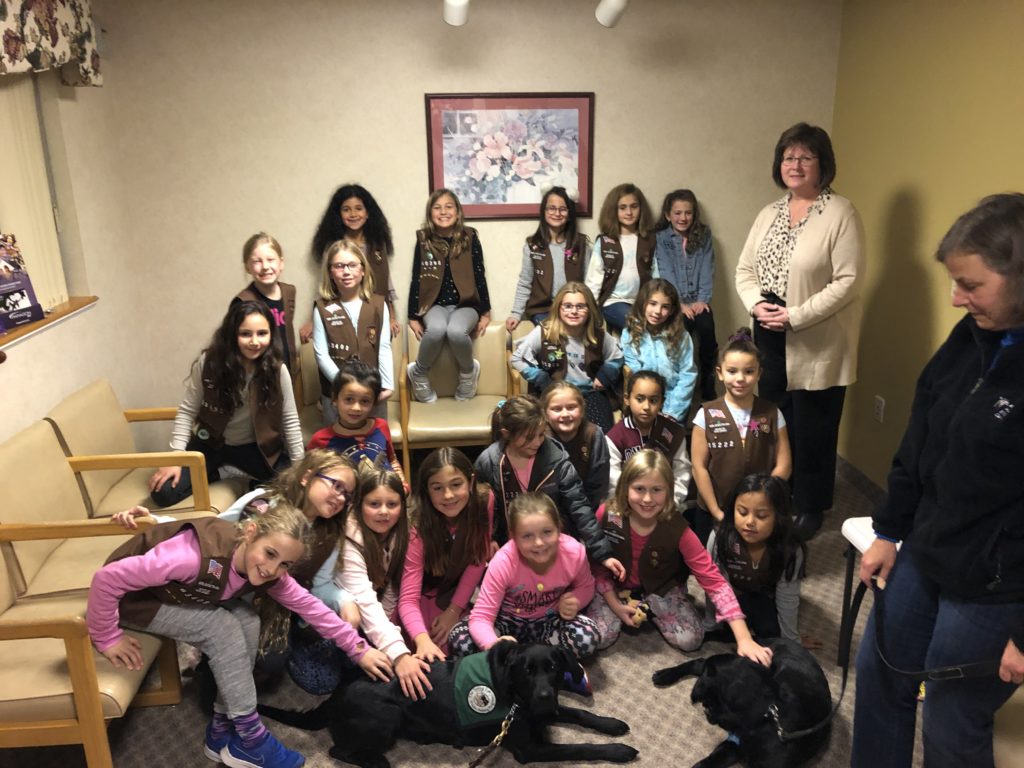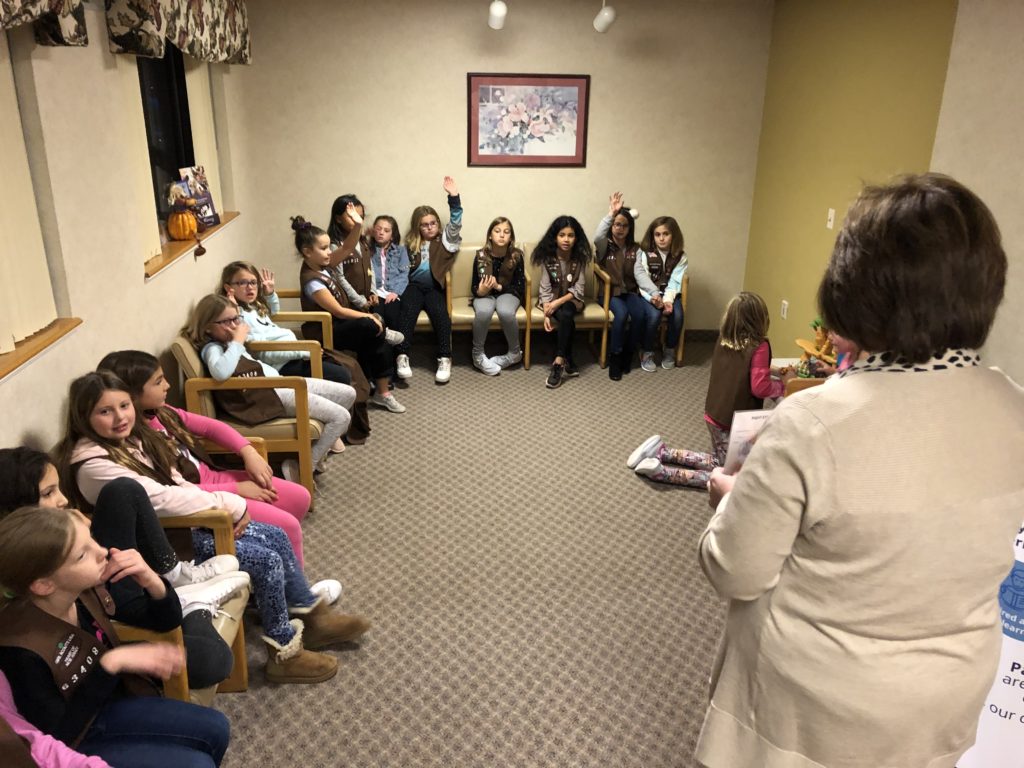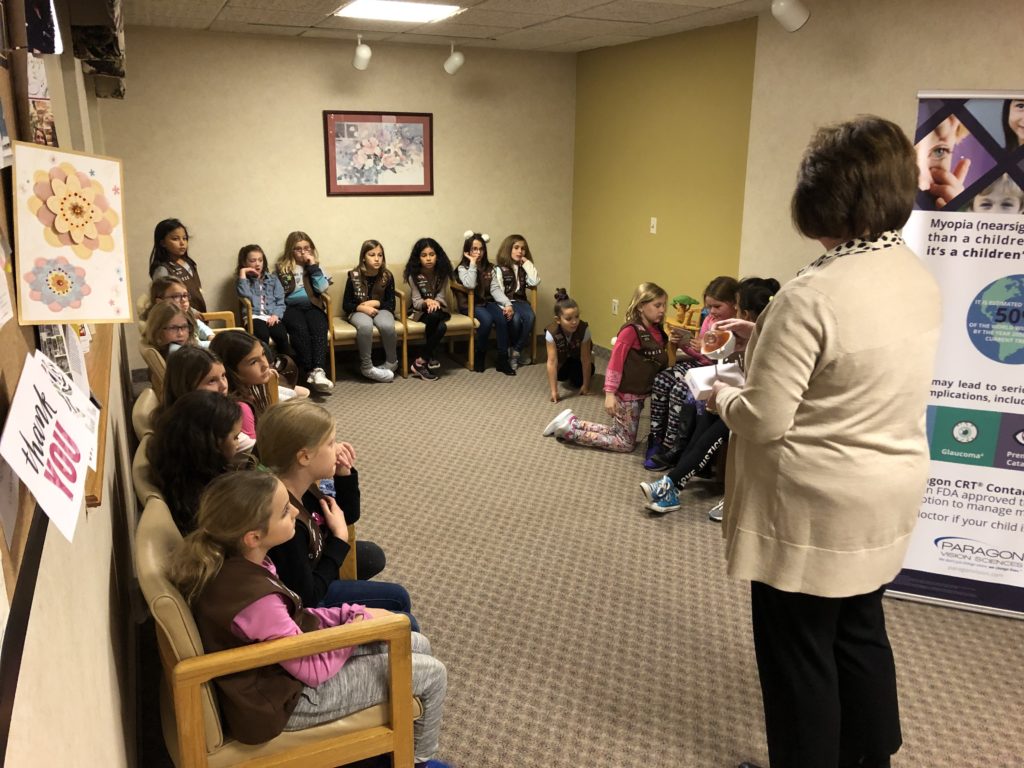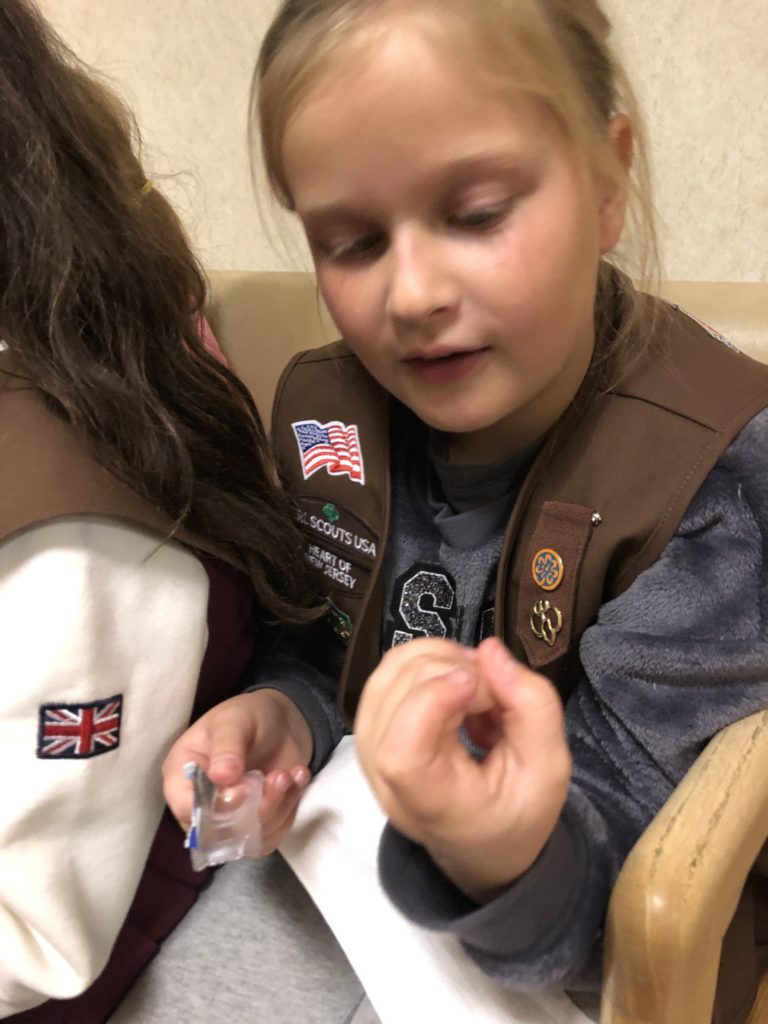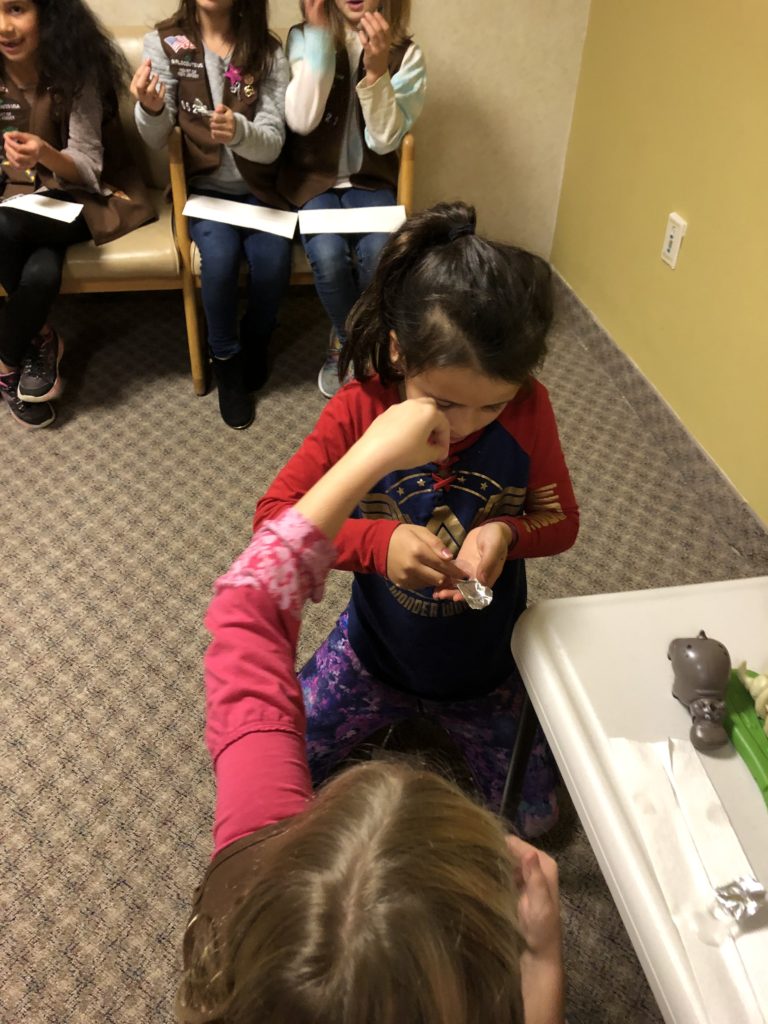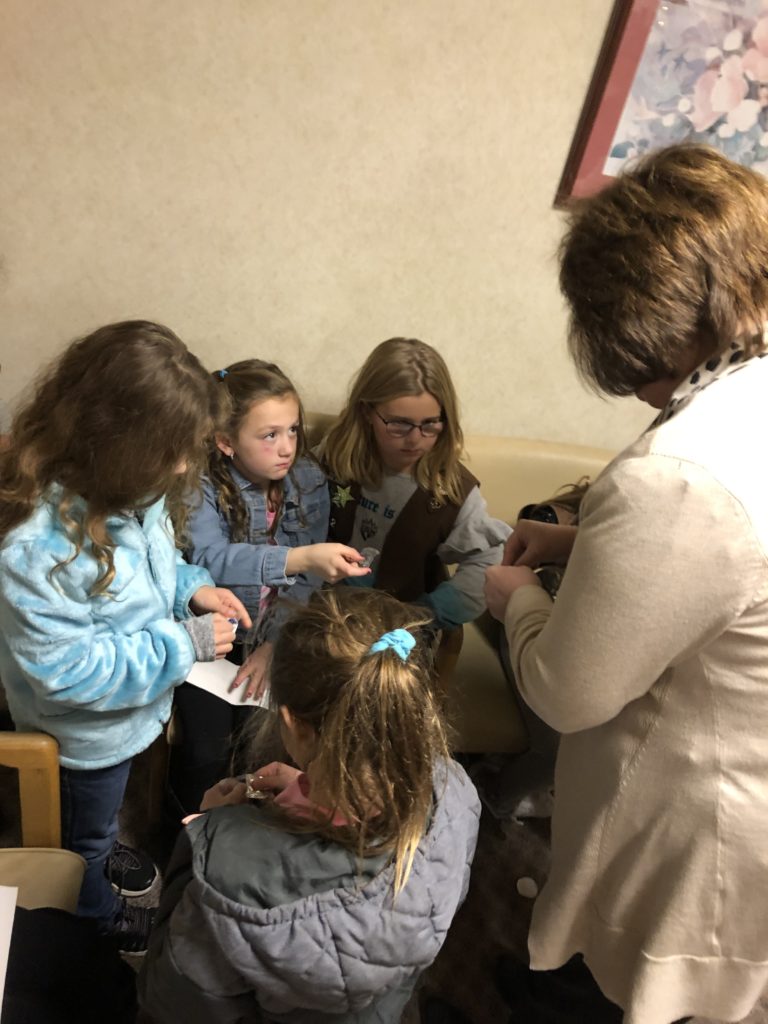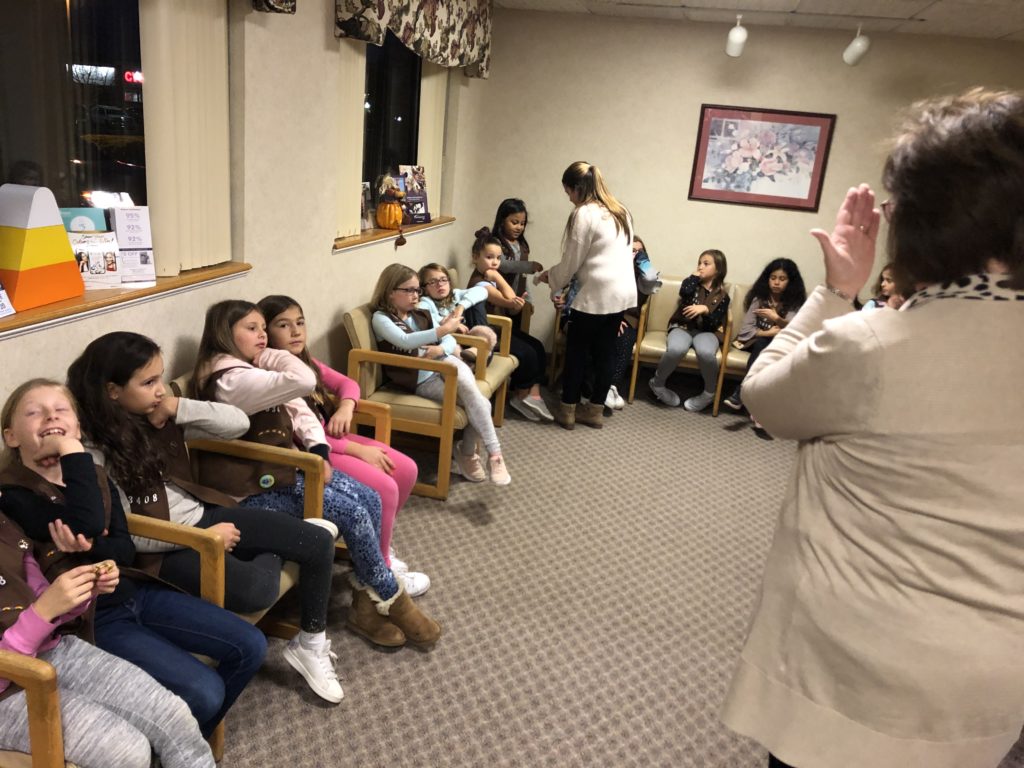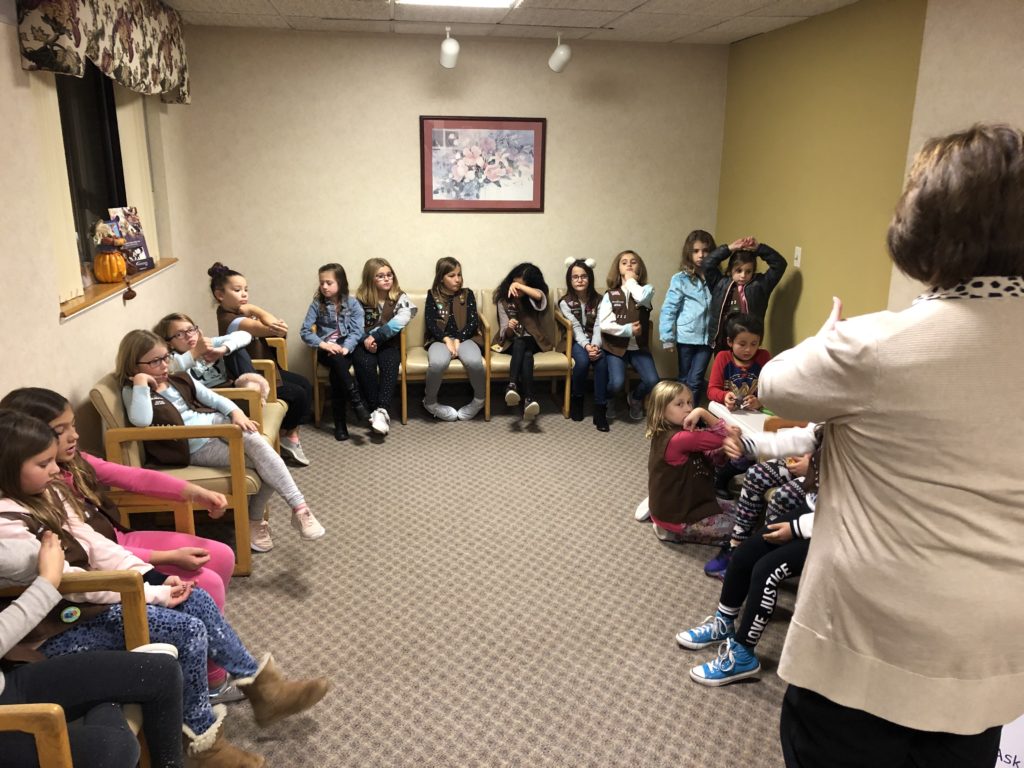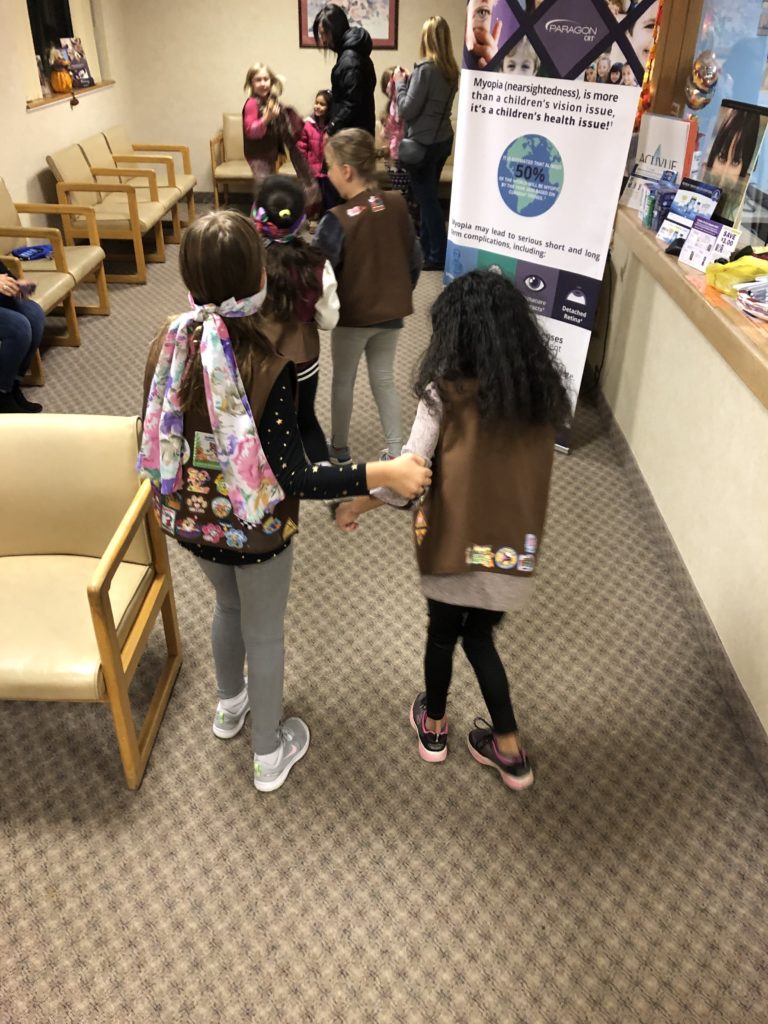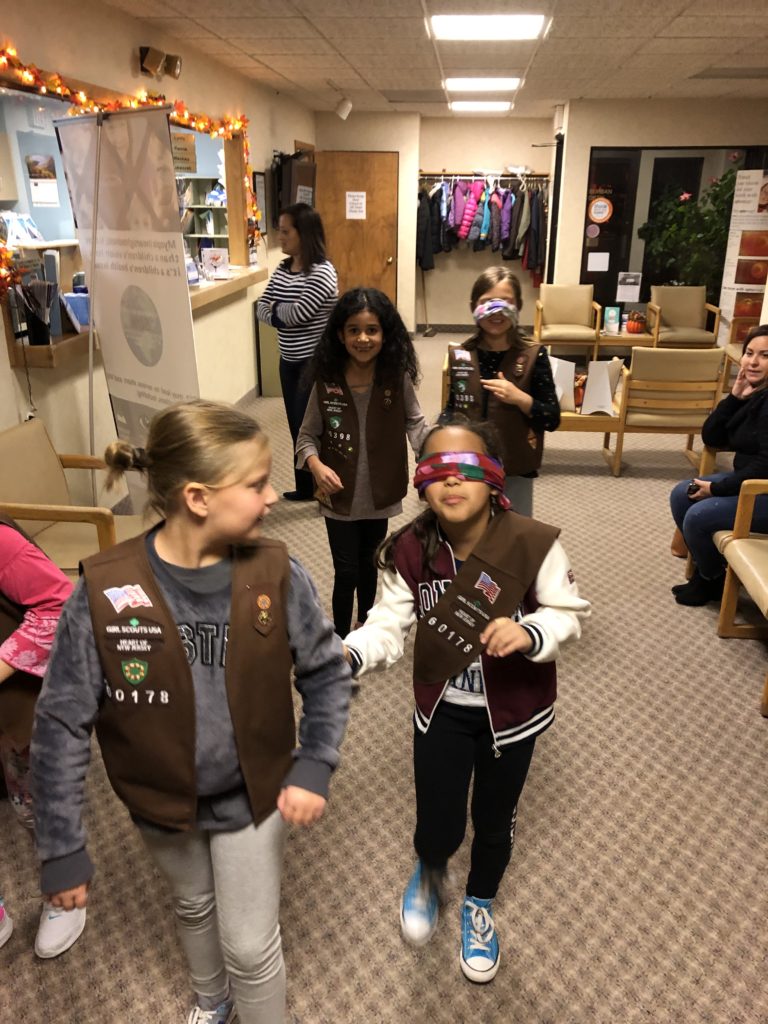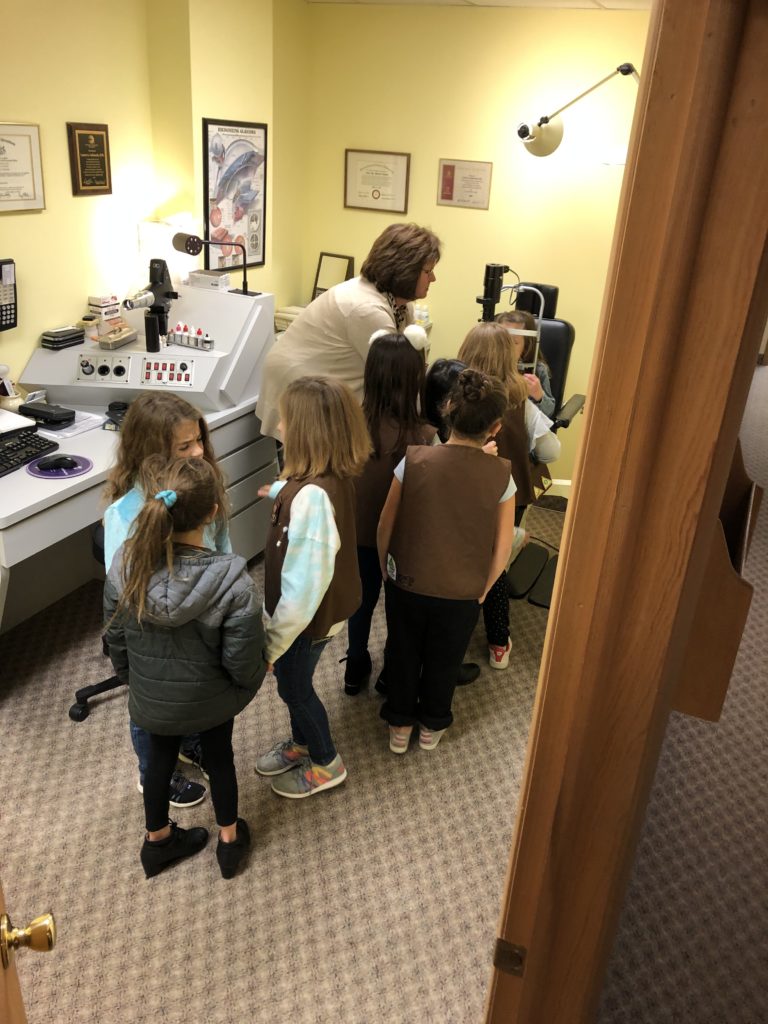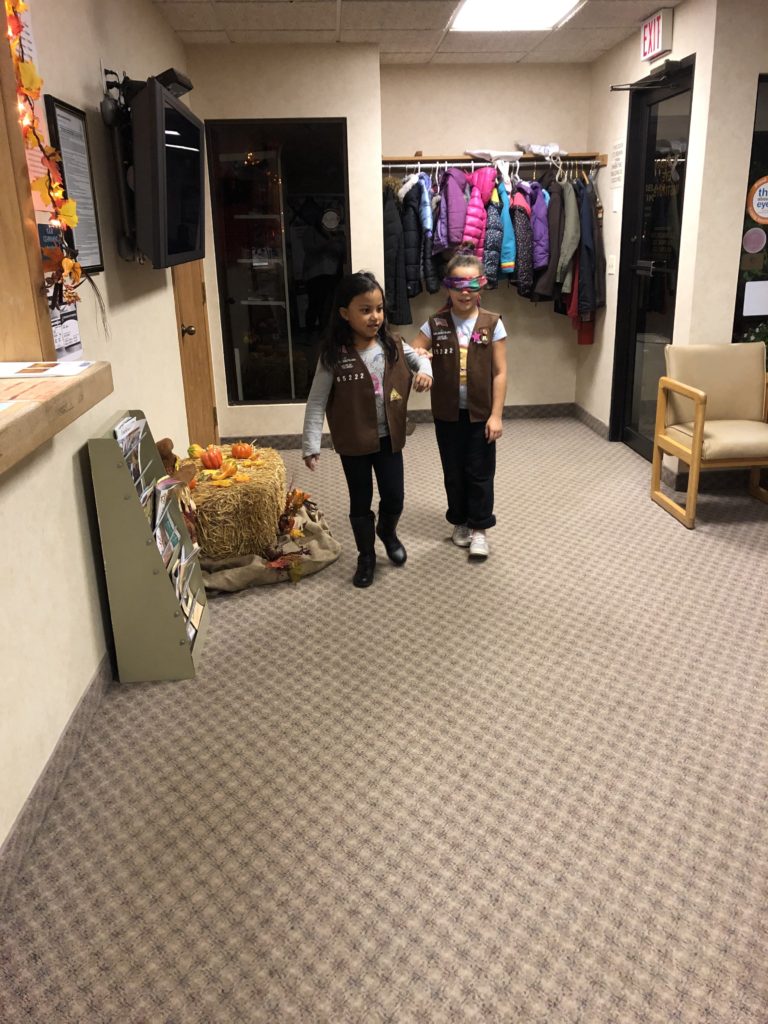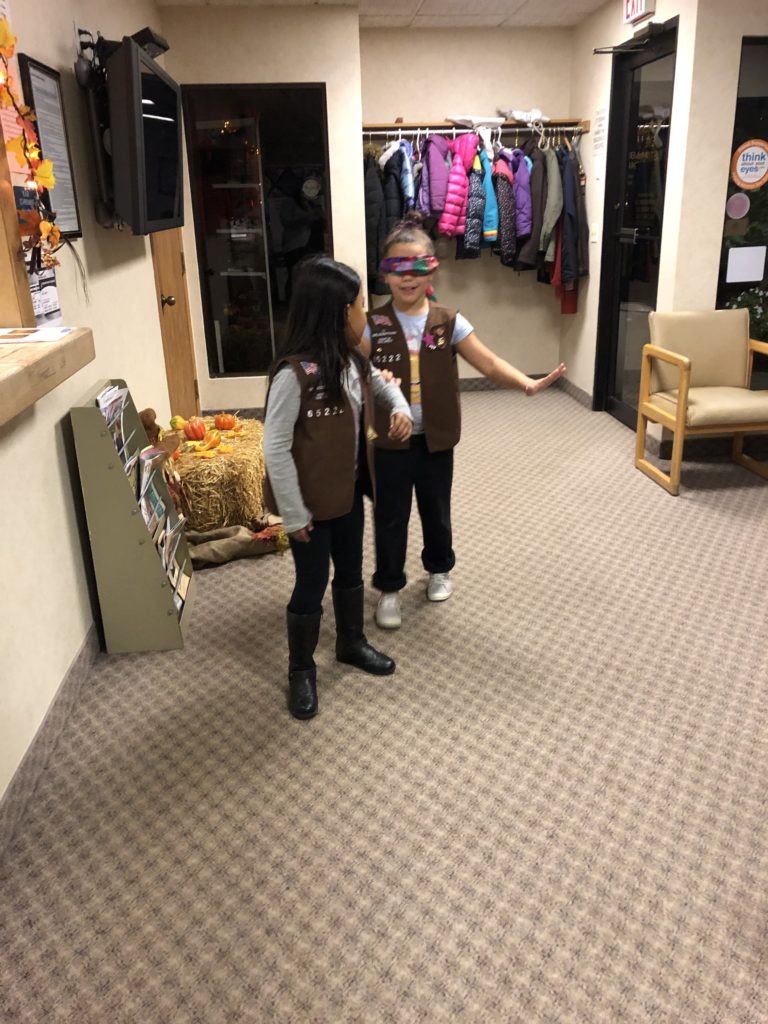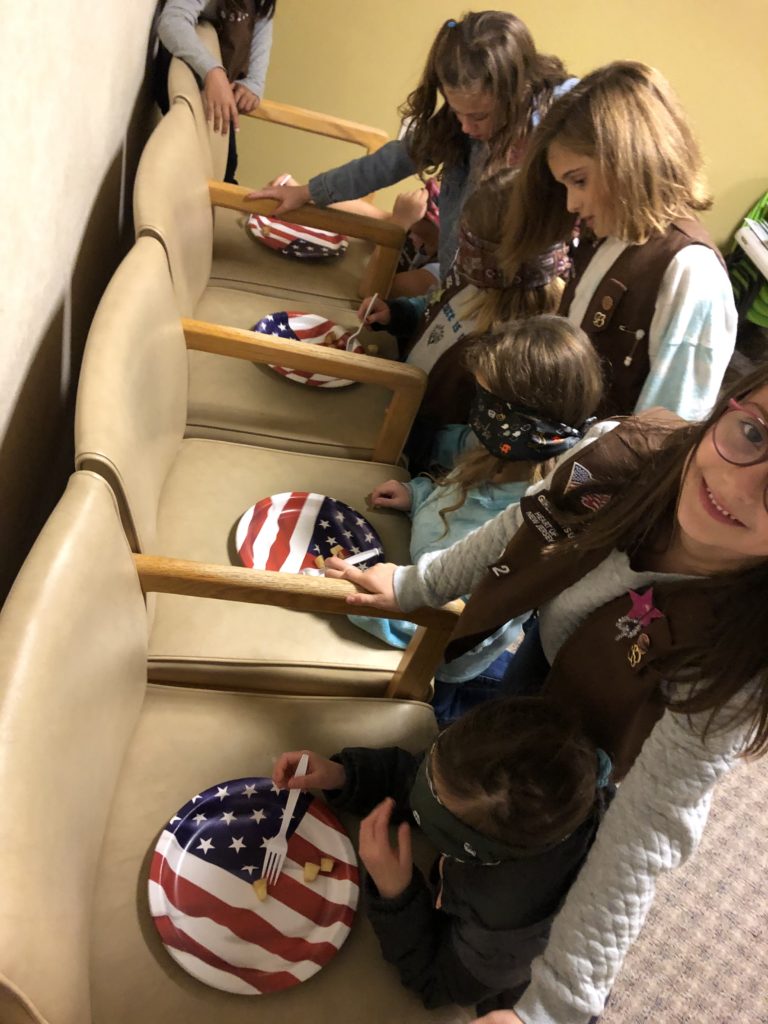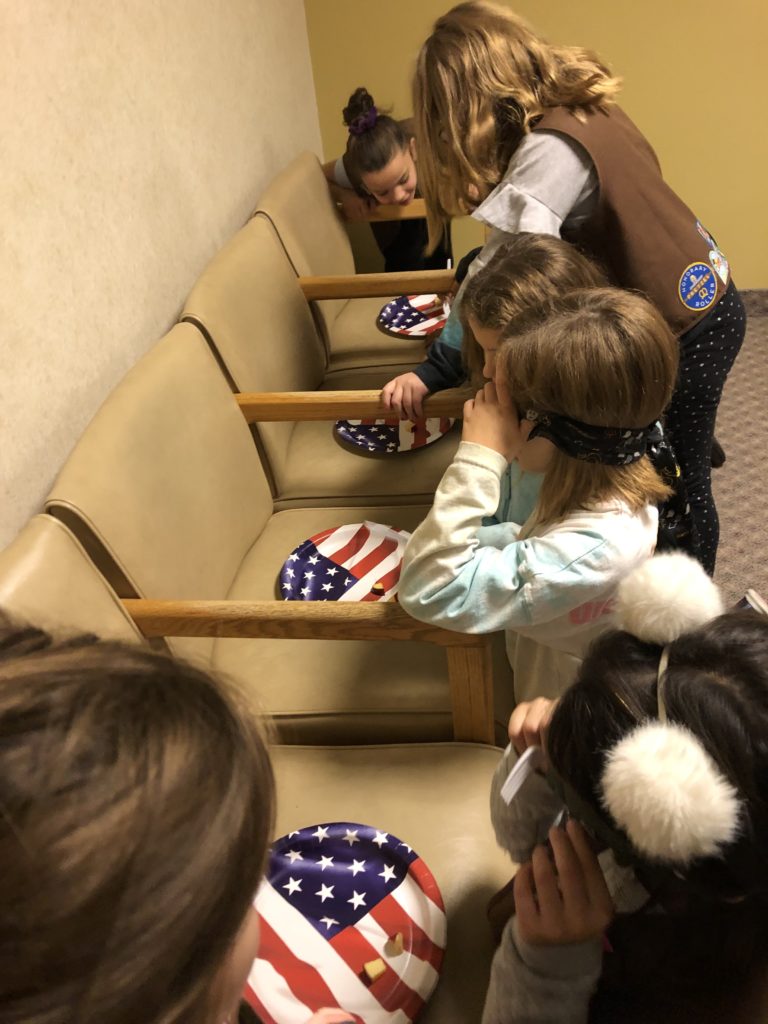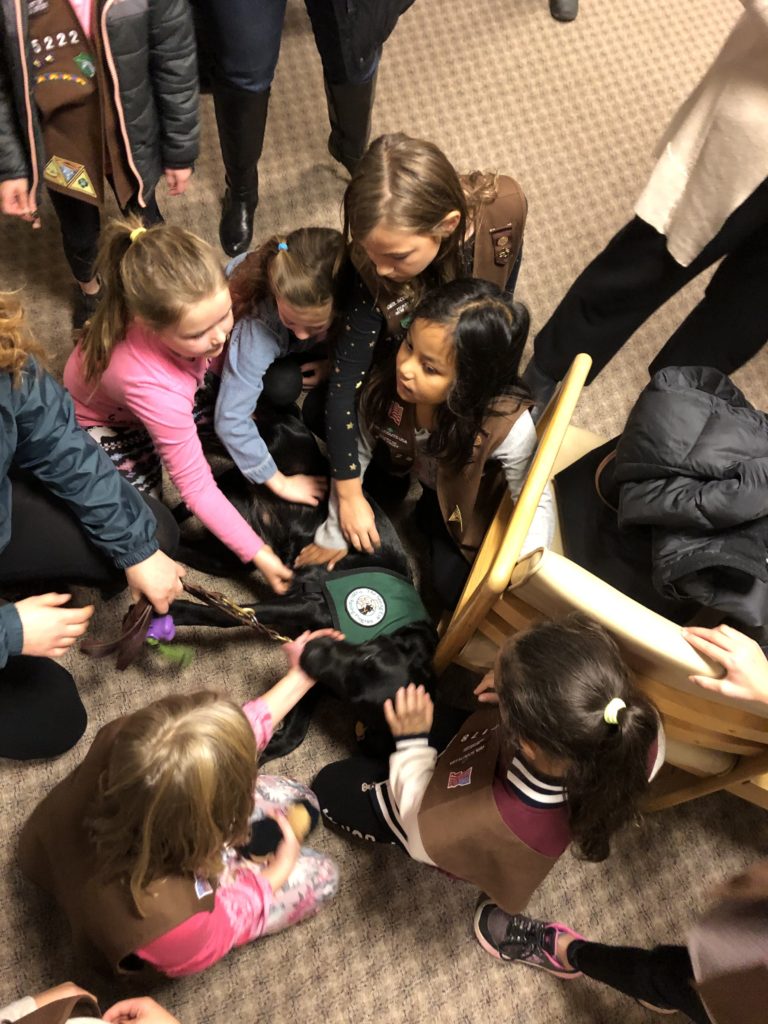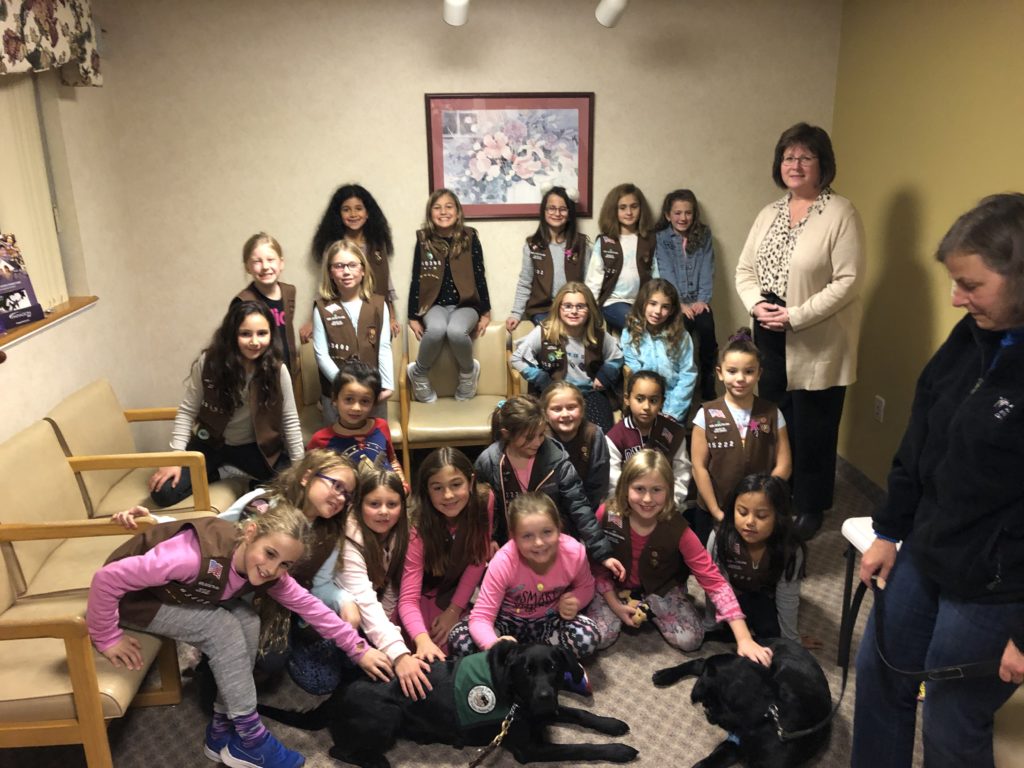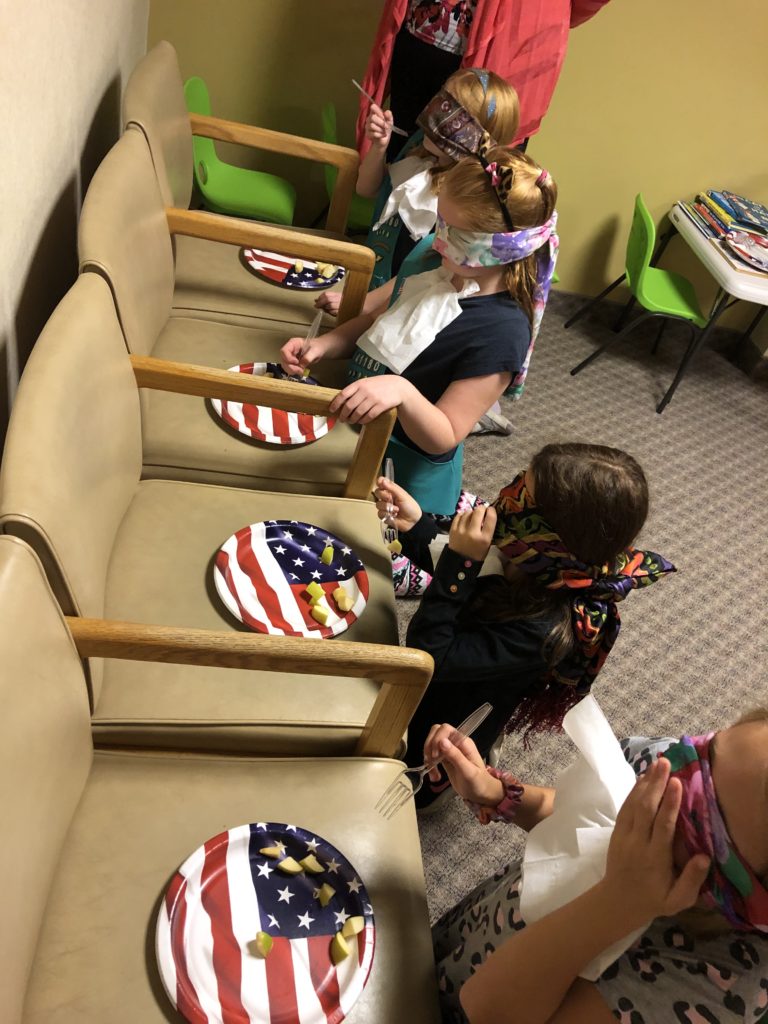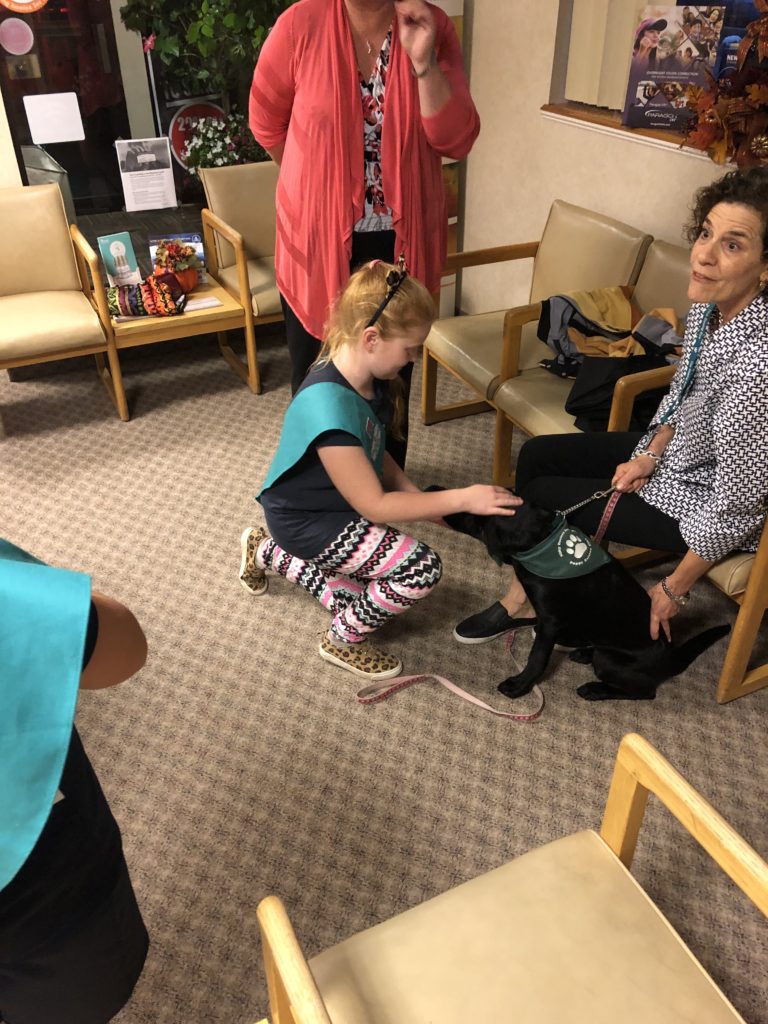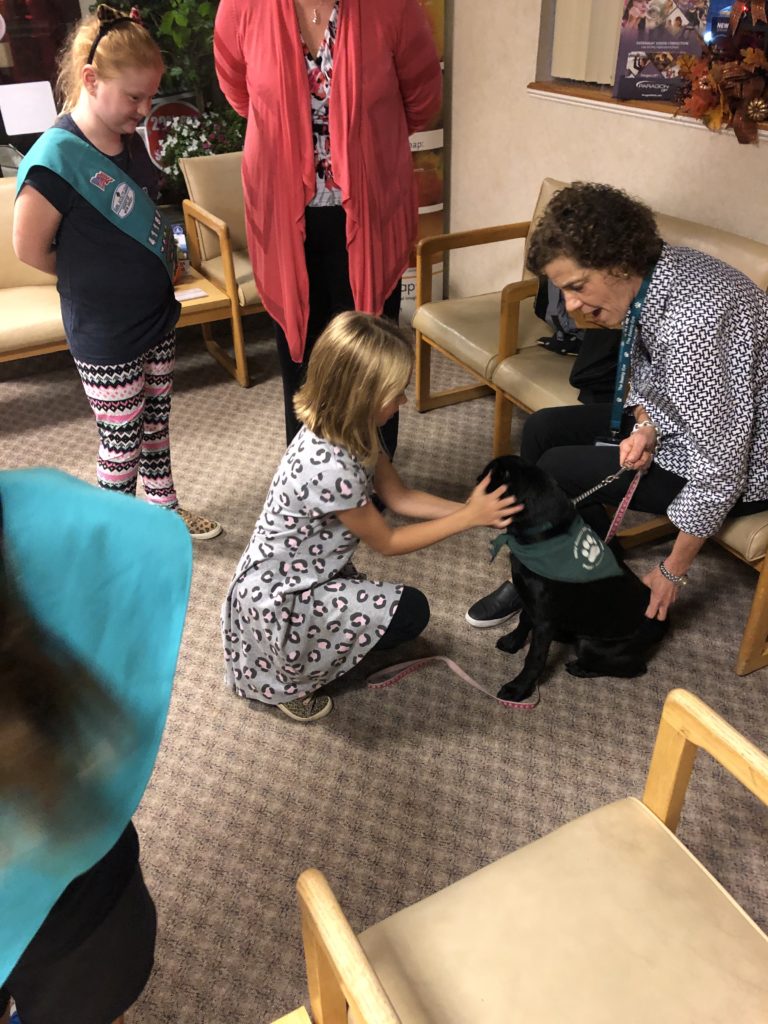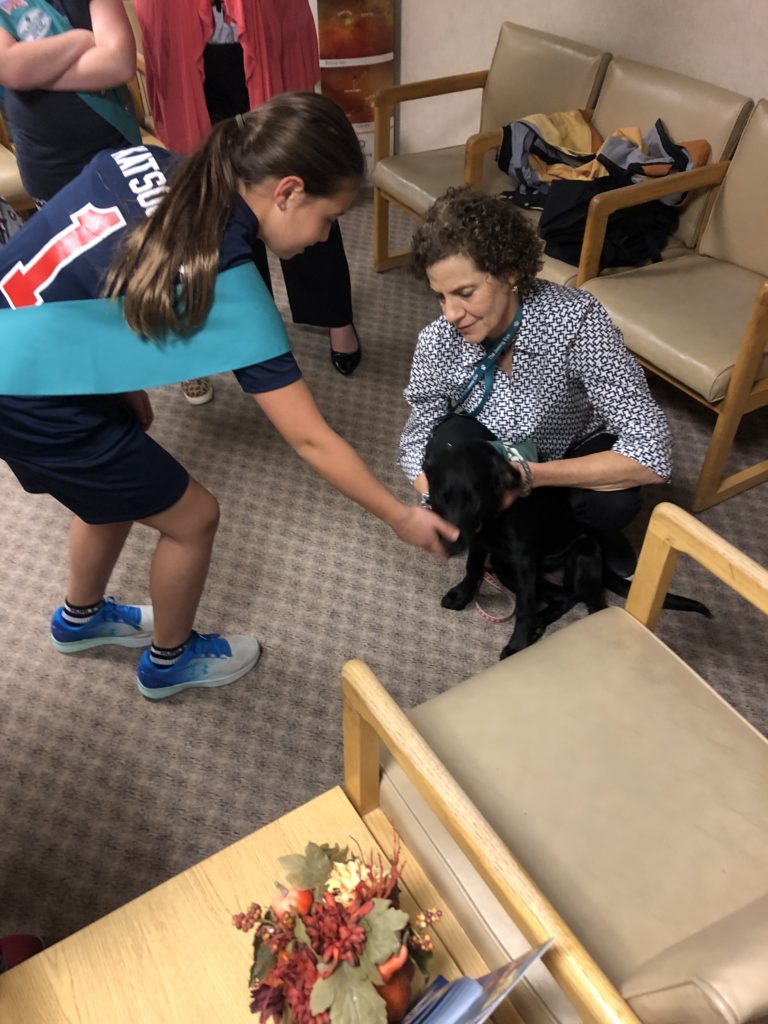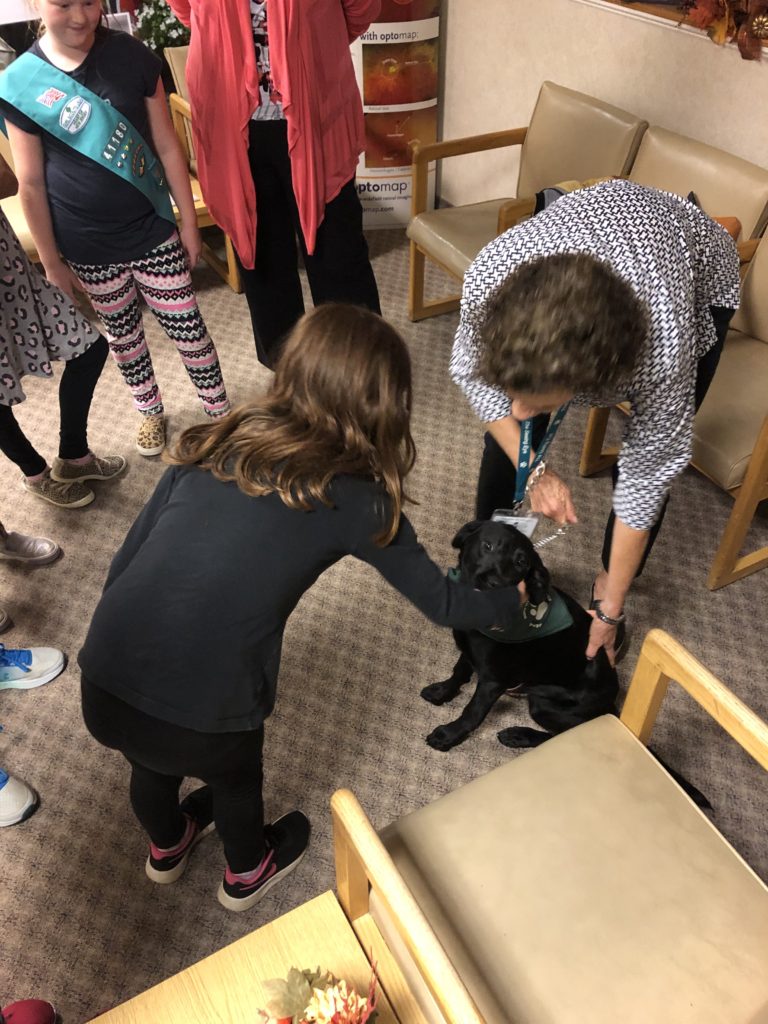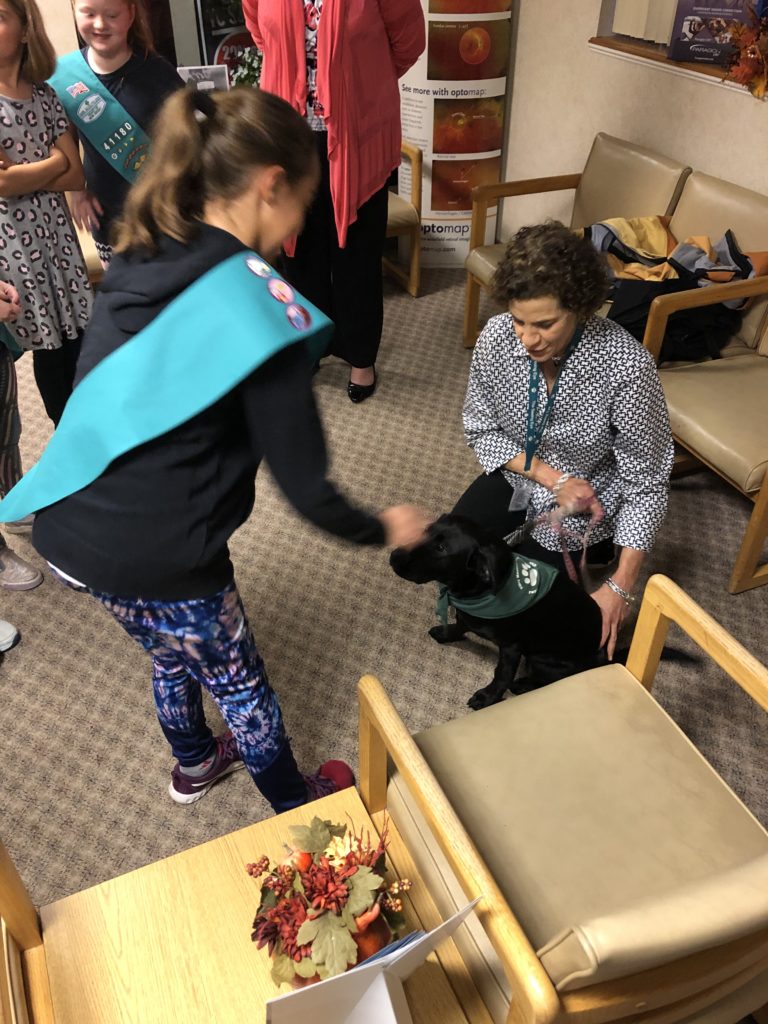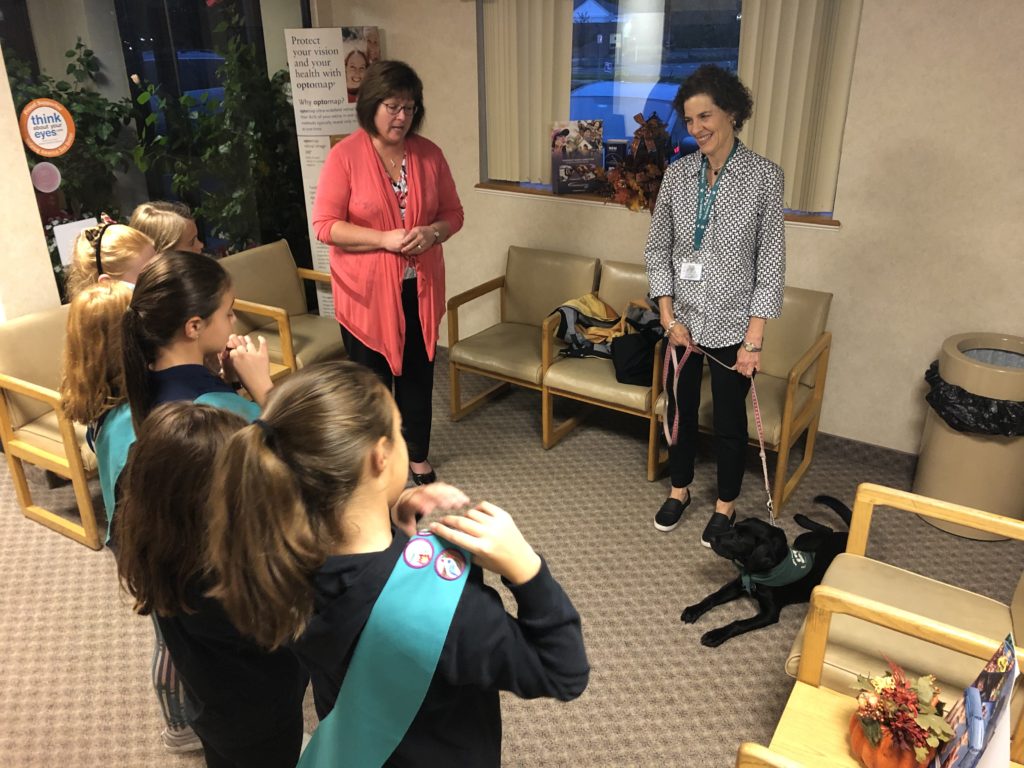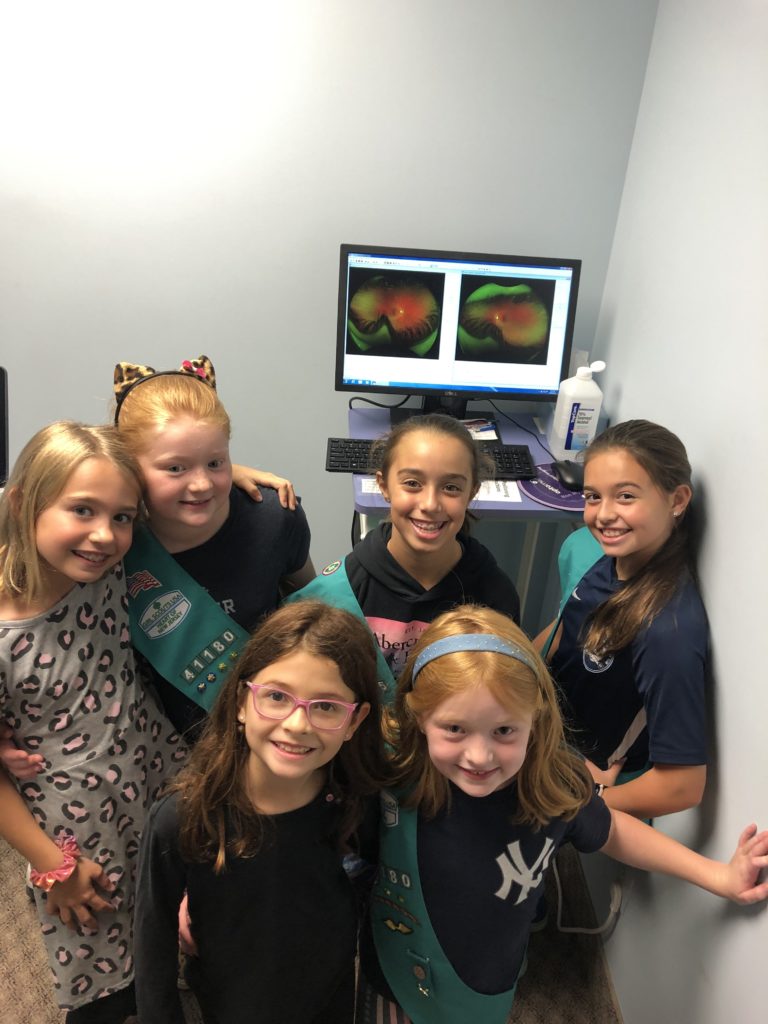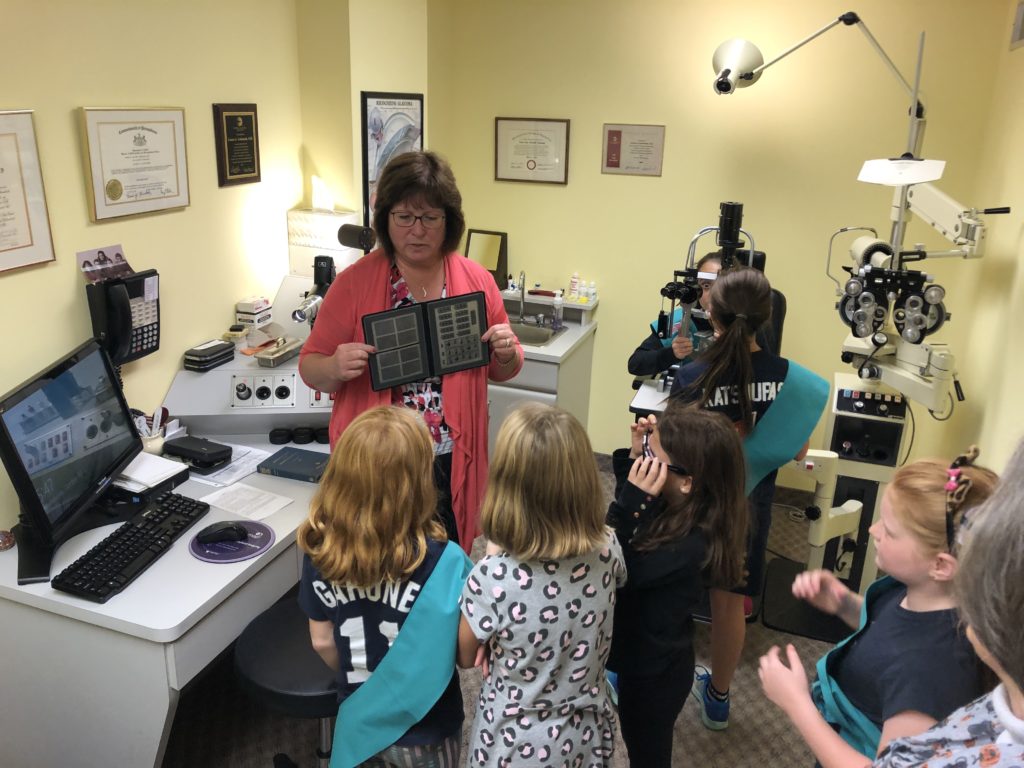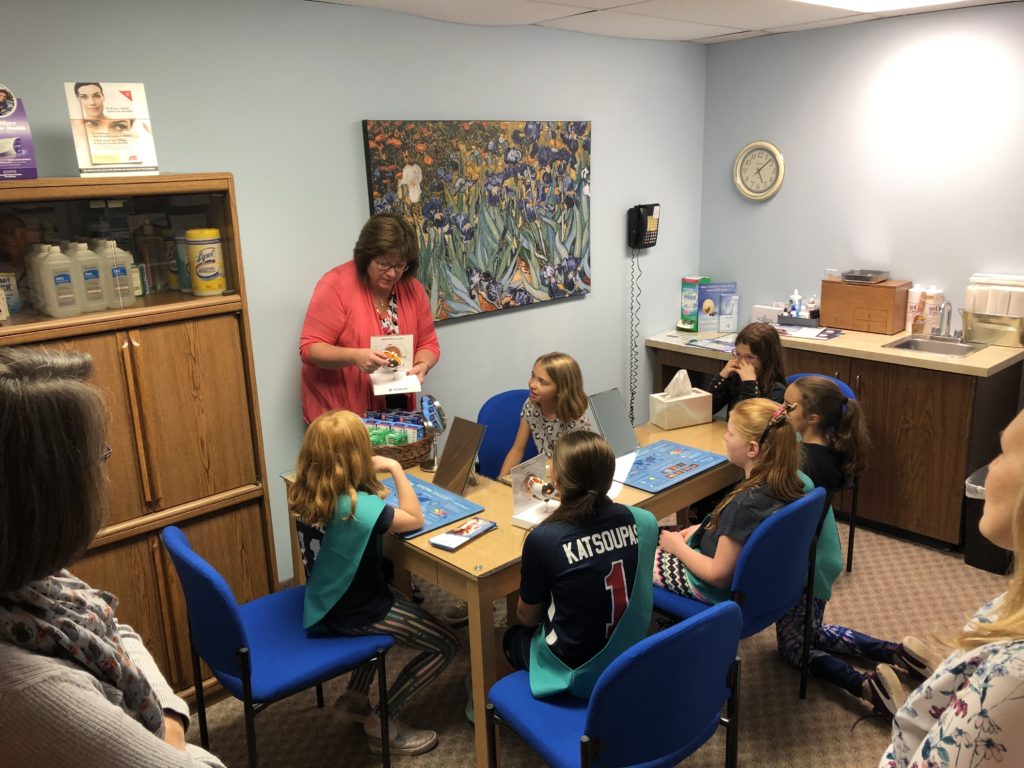We had yet another very successful Girl Scouts event. This time with the local Brownies troup. We had a blast learning all about the anatomy of the eye, the doctors tools, and what its really like to walk and eat with low or no vision. We also got to meet two more local seeing eye puppies! What fun!!
Author: Laura Lukaszek
Girl Scouts Earn Vision Awareness Badges
Last night we had the pleasure of having six of our lovely local Girl Scouts come and earn their Vision Awareness Badges! We had so much fun!! We learned a little about the anatomy of the eye, took turns taking Optomap pictures of each girl and learned all about the macula and optic nerve. The girls took turns looking through the doctors slit lamp to see what the doctor sees during an exam. They also learned what it’s like to try to walk and even eat for people with low or no vision, and they even had a special visit from a local seeing eye puppy and her raiser!! What fun!!
Use It or Lose It
As we approach the end of 2019 we wanted to send out a friendly reminder to everyone, do not forget to use your benefits before the year is over! Spots are limited this time of year with the rush of people trying to get their eye exams in and their FSA or HSA used up before the year is over! We want to make sure everyone can be seen in a timely fashion so they don’t lose out on their benefits for the year!! Call our office as soon as possible to make an appointment with one of our doctors!!
Here is a list of the insurances we currently participate with:
-Horizon Blue Cross and Blue Shield (most plans)
-Aetna
-UnitedHealthcare (specific doctors only)
-Medicare (with or without supplements)
-Qualcare (most plans)
-PVCN (discount plan)
We also accept FSA and HSA cards as forms of payment as well!!
**THIS DOES NOT GUARANTEE PAYMENT FROM INSURANCE COMPANIES, PLEASE CONTACT YOUR INSURANCE TO FIND OUT YOUR EXACT BENEFITS**
**Unfortunately we DO NOT participate with any SEPARATE VISION PLANS. If you have a separate vision plan through any of these companies the visit will need to be paid out of pocket and submitted to the insurance company independently.**
Ortho-K Program At The Sububan Eye Institute
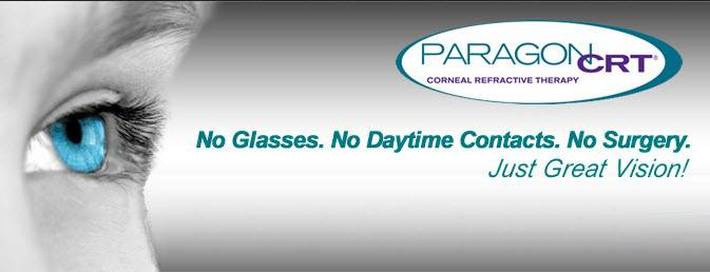
Great option for an active lifestyle, for both children and adults!
“Ortho-K” is a non-surgical treatment that helps correct distance vision without the use of daytime contact lenses or glasses.
Call to set up your regular eye exam and receive a complimentary consultation to see if you are a candidate for the Orthokeratology Program!
369 Springfield Ave ~ Berkeley Heights, NJ 07922
Phone: 908-464-0123 ~ Website: suburbaneyenj.com
Our Orthokeratology Program
Orthokeratology Program at Suburban Eye Institute
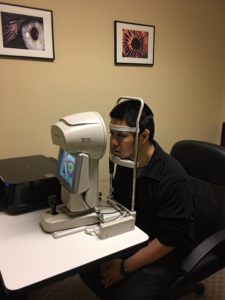
This month we would like to take a quick look at how Orthokeratology works. Orthokeratology is a less invasive therapy that is used as an alternative to LASIK. This is a non-surgical process that allows patients to break free from their dependence on glasses and daytime contact lenses. This program can also be performed starting at a young age. At the end of this article we will also answer three of our most frequently asked questions.
How It Works:
Orthokeratology uses specially designed and patient specific lenses to gently reshape the cornea while the patient is sleeping. When the patient removes the lenses the next morning they are able to go about their day free of glasses or contact lenses. To determine candidacy, patients will need a consultation with the doctor. At this visit the doctor will perform a basic eye exam. (It is recommended that patients have one every year to be sure their eyes are healthy.) The doctor will then perform tests and measurements that will be necessary later to determine if the patient is an appropriate candidate for the Orthokeratology program. Each exam, pair of lenses, and treatment program is patient specific. Each customized program is performed with the end goal of providing the patient with sharp, clear, and natural vision all day long.
Equipment:
Our office has all of the equipment necessary to participate in the Orthokeratology program. The piece of equipment used most often for our Orthokeratology patients is our Topographer. Topography is a non invasive way to look at the surface of the cornea. It is also one of the ways the doctor determines whether or not the patient is a candidate. The results show how much correction the candidate will need to complete the program. These measurements will also help the doctor to determine the customized prescription lenses for each patient’s individual case.
Orthokeratology is reversible if the patient stops wearing the lenses as prescribed by the doctor. Many have found it to be an excellent and less invasive alternative to LASIK.
Frequently Asked Questions:
- Question: “Will Orthokeratology be covered by my insurance?”
Answer: No, like LASIK, Orthokeratology is an elective procedure and will not be covered by most insurance companies. However, we do accept FSA and HSA accounts and patients are more than welcome to use them to pay for this program. - Question: “Does Orthokeratology hurt?”
Answer: No, this program is virtually painless. There is a break in period when the patients first begins wearing the lenses. Much like when you buy a new pair of shoes, the patient might have an awareness of the lens itself in their eye if they are thinking about it. There will be no sensation of physical changes to the cornea itself. Our goal is that the patient will notice visual improvements as soon as the lenses are removed from their eyes. - Question: “How long does the Orthokeratology Program take to correct my vision to 20/20?”
Answer: The answer to this is case specific. Most patients should notice a marked difference in their vision within the first couple of days in the program. After that, the vision should gradually improve over the next couple of weeks until patients have reached their optimal vision as determined by the doctor.
All of our doctors are CRT Certified.
They can all be found on www.ortho-k.net or
http://www.paragonvision.com/consumer/find-a-doctor
For the doctors specific appointment hours please give our office a call. We will be happy to find an appointment time that fits into your busy schedules. Don’t forget to keep checking in on our webpage and our Facebook page for the most up-to-date information!
Dr. Laura Lukaszek: Monday – Thursday
Dr. Brian Mackey: Tuesday & Thursday – Saturday
Dr. Brenda Lynly: Monday & Wednesday
Roxy Found Her Human
We are so proud to announce that Roxy, a seeing eye dog trained by Dr. Lukaszek, has found her human. Dr. Lukaszek received a letter from Roxy’s human letting her know she is happily settled and has been on quite a few adventures already! We are so happy Roxy has found a happy and loving home!
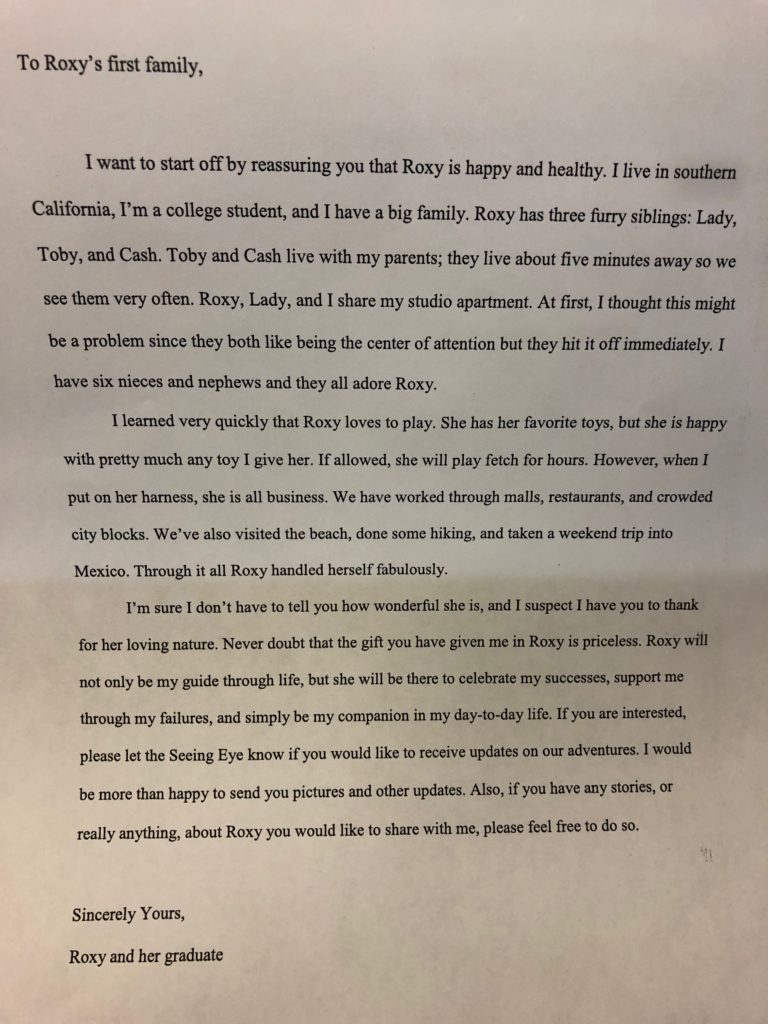

Transition Contact Lenses from Acuvue Have Arrived!
Are you bothered by light? Do you love your contact lenses but hate that you have to put on sunglasses to combat those bright lights? Acuvue has now introduced the first-of-its-kind contact lens that seamlessly adapts to changing light to provide all-day soothing vision. Still not sure if the lenses are for you, no problem. This article will go through some of the most frequently asked questions provided by Johnson & Johnson. Then feel free to call our office and we would be happy to set up a consultation for you!
Q: How will these lenses look on my eyes?
A: These lenses are specifically designed to provide as much benefit to the patient while minimizing the changes to the appearance of their eyes. The contact lenses do not change the appearance of the patients eyes anymore than a pair of sunglasses or transitional glasses lenses would. The image on the left below shows the lens before it has been transitioned. The image on the right below shows the lens after it has been transitioned.
Light Eyes:


Dark Eyes:


Q: Can I wear these lenses while I’m Driving?
A: Yes, they are safe to wear while driving both during the day and at night. Based on the HEV light and UV light that comes through your side windows (since windshields are made to block 100% of UV light) the lenses are expected to activate during the day.
Q: Do I still need to wear sunglasses while wearing Acuvue Oasys with Transition lenses?
A: Yes. While these lenses do provide UV protection to the areas of the eye that they cover, the rest of the eye and surrounding eye area are still exposed to UV light. Because of this, Acuvue Oasys with Transitions are not intended as replacements to sunglasses.
Q: Do these lenses work indoors?
A: Yes. Even in their clear state, these lenses are filtering light. This technology is designed to adapt automatically (becoming lighter or darker) in response to changing light. Acuvue Oasys with Transitions is always “on”.
Q: How long does it take the lenses to activate? And how long does it take to fade back?
A: These lenses activate in less than a minute, and takes about 90 seconds to fade back to clear when going from outside to inside.
If would like to see a demonstration of the lenses in action give our office a call and set up your consultation today!
What is The Optomap?
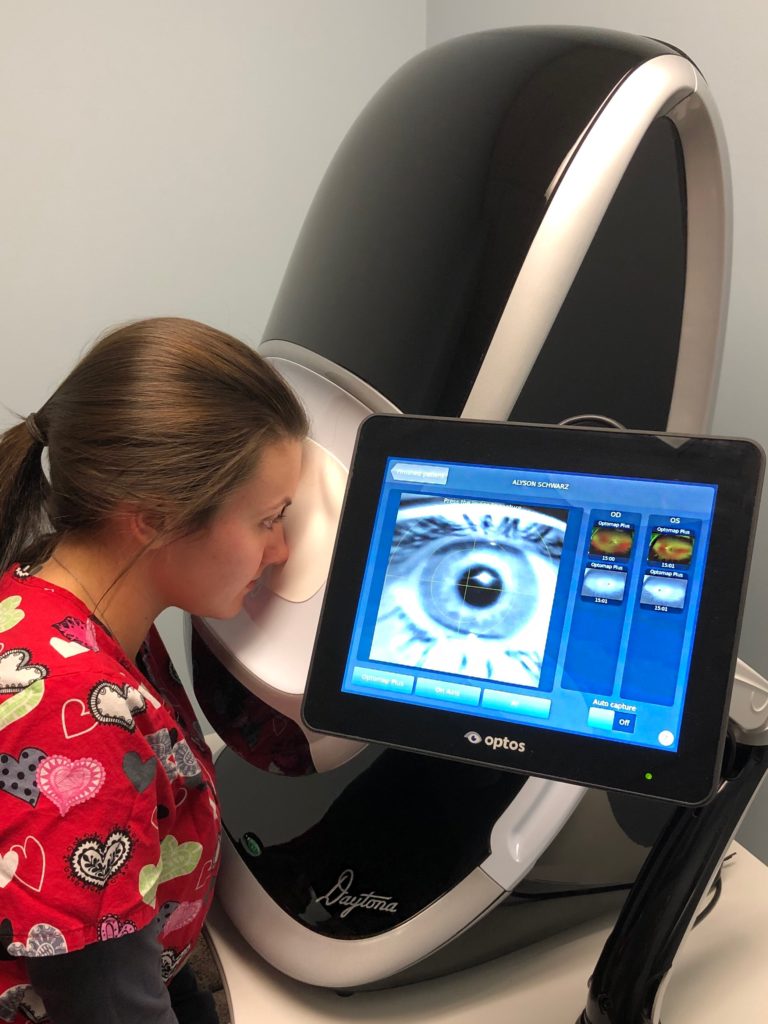
When performing the Optomap on patients we are frequently asked, “What is the purpose of this test? Do I really need this?” This article goes through some of the benefits as well as some of our most frequently asked questions. Often there are things going on in your body you are unaware of, and an Optomap can be a window to look inside and see what’s going on. We are hoping to shed some light on this portion of your exam and hope to help you understand the importance of proper eye health and preventative care.
The Optomap image screenings are used to check your retina, which is located in the back of your eye. The retina is the only place in your body where the nervous system and the circulatory system can be directly seen without cutting the body open. Traditional methods to see the retina include the use of what is known as a slit lamp and/or dilation. A slit lamp is a piece of equipment that uses a narrow bright beam of light and a small mirror to see the interior of the eye. Another traditional method is dilation of the pupil. However, dilation alone is not enough for the doctor to see all the way into the eye to the retina. Dilation is used to assist the doctor when using the slit lamp, it opens the pupil when the pupil is too small to see into the back of the eye. With these traditional methods however, the doctor is only able to see 15% of the retina. With an Optomap, the doctor is able to see 80% of the retina. This is a HUGE difference, 65% more of the retina can be seen using Optomap imaging. Early signs of pathology can present in the periphery of your retina and remain undetected for a long time with traditional methods. Early detection is key and the Optomap allows the doctor to see more of the periphery and to see it sooner!! Early detection means successful treatments can be administered and can greatly reduce risk to not only sight, but many other health problems.
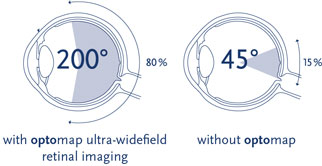
With an Optomap the doctor will see if your macula and retina are both healthy. They will also see floaters, retinal detachments, retinal hemorrhages, and many other eye problems. Optomap imaging is a useful tool for early detection of other health problems such as: heart disease, hypertension, cancer, and diabetes. All of these health problems and many more can be detected by monitoring your retina. Changes in your retina are seen using Optomap imaging long before you notice any changes in your vision or other physical symptoms or pain.
Optomap images are quick and painless. Nothing touches the eye itself and the image is captured in less than ½ a second. The images are taken one eye at a time. Our staff takes two pictures of each eye. The second image is taken using an auto-fluorescent setting that allows the doctors to see if there are any leaks in the blood vessels. The instrument uses a bright flash of light, similar to the flash of a camera, and internal mirrors to capture the image. The images captured are available to the doctor right away, along with a 3D animation of the eyeball. The 3D image projects your retinal image to show you exactly where everything is, exactly as it appears in your eye.
FAQ’s:
Q: Is there an age requirement? Is an Optomap safe for kids?
A: Yes, the Optomap testing process is safe for children and adults. There is no age requirement or limit. It is also non-invasive and completely painless. Many vision problems begin during early childhood so early intervention is key to preserving vision.
Q: How often should I have an Optomap performed?
A: Generally, it is recommended to be done with each routine eye exam. For a more specific recommendation, ask your doctor at your next exam and they would be happy to come up with a custom care plan for your individual case.
Q: How does this help me as a patient?
A: Optomap images can help the doctor to detect problems in a faster, more efficient, and more comfortable way. Optomap images are also kept in the patients file for future reference and/or comparisons. Having a baseline image to compare future images to is extremely beneficial to the patient, as well as the doctor, and can lead to earlier detection and intervention if a problem should arise. Early intervention is key in preventing loss of vision or other serious health issues.
Q: Will I need to be dilated and does it hurt?
A: An Optomap is not painful and only take seconds to perform. You do not need to be dilated to perform the test, however your doctor may decide dilation is still necessary.
!NOW ACCEPTING!
Suburban Eye Institute Doctors are now accepting select United Healthcare insurance plans!
PLANS CURRENTLY ACCEPTED:
Horizon Blue Cross/Blue Shield Plans
Aetna Plans
Medeicare and Supplimental Plans
Select Qualcare Plans
Select United Healthcare Plans
Also accepting all FSA, HSA, and other health savings plans.
Don’t know if we participate? Give the office a call, one of our office staff would be happy to help you!
Not sure if you are due for your annual exam yet? Give the office a call and one of our office staff would be happy to look up your account and let you know when you will be due.
Want to set up your annual eye exam? You can head on over to our contact page and send in a form. Be sure to give us the best day and time for you and we will get right back to you with an appointment. You can also feel free to give the office a call if that is easier for you, and a member of our staff would be happy to set up your exam!
Suburban Eye Institute 908-464-0123
Lindsay The Seeing Eye Dog Has Been Placed!
We are pleased to announce that our sweet Lindsay has been placed with her human! Lindsay is Dr. Lukaszek’s 6th seeing eye dog she has trained and is currently training her 7th. Lindsay will forever be a member of the Suburban Eye Institute family and we could not be more proud of her!

